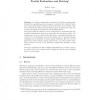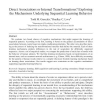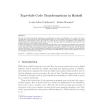846 search results - page 40 / 170 » Transforming structures by set interpretations |
IPPS
1999
IEEE
14 years 2 months ago
1999
IEEE
A structured approach to parallel programming allows to construct applications by composing skeletons, i.e., recurring patterns of task- and data-parallelism. First academic and co...
ERSHOV
1999
Springer
14 years 2 months ago
1999
Springer
Abstract. An abstract framework is developed to describe program transformation by specializing a given program to a restricted set of inputs. Particular cases include partial eval...
COGSCI
2010
13 years 10 months ago
2010
We evaluate two broad classes of cognitive mechanisms that might support the learning of sequential patterns. According to the first, learning is based on the gradual accumulation...
ENTCS
2007
13 years 10 months ago
2007
The use of typed intermediate languages can significantly increase the reliability of a compiler. By typechecking the code produced at each transformation stage, one can identify...
ICFP
2006
ACM
14 years 10 months ago
2006
ACM
Often, independent organizations define and advocate different XML formats for a similar purpose and, as a result, application programs need to mutually convert between such forma...



